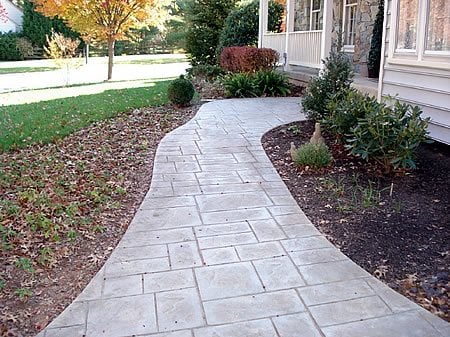- Concrete Walkways and Sidewalks
- Concrete Walkway Pictures
- Decorative Finishes for Existing Walkways
- Fix and Color Existing Concrete Walkways
- Sidewalk Repair - Resurfacing Concrete Walkways
- Design Ideas for Concrete Walkways
- 10 Ideas for Concrete Entryways
- Stairs and Steps
- Stamped Concrete Walkways
- Concrete Garden Bridges
- Front Porch Designs and Ideas
- Installing and Maintaining Concrete Walkways
- Concrete Walkway Cost
- DIY Concrete Sidewalk
- Building Tips for Concrete Sidewalks & Walkways
- Sealing and Protecting Walkways & Sidewalks
- Sidewalk Pavers
- Other Resources
- Concrete Contractors: Find Products and Suppliers
How to Build Concrete Sidewalks and Walkways
One of the biggest appeals of concrete sidewalks is their long service life, which averages from 20 to 40 years, according to the National Research Council of Canada's Institute for Research in Construction (NRC-IRC). The key factor in sidewalk longevity is the quality of construction. Even a concrete sidewalk can fail after several years if poor materials are used and good design and construction practices are ignored.
The NRC-IRC publication Best Practices for Concrete Sidewalk Construction offers these tips for ensuring problem-free walkways that will give you decades of good performance. First and foremost, be sure to hire a reputable decorative concrete contractor to install your sidewalk.
- Proper compaction and preparation of the subgrade beneath the sidewalk is essential. The uniformity of the compaction is just as important as the degree of compaction. Uniform compaction diminishes differential settlement of the concrete sidewalk and reduces the chance of crack development.
- Although concrete can be placed directly on the subgrade, it's much better to place a granular subbase layer between the compacted subgrade and the concrete slab to provide more uniform support and to bridge over minor subgrade defects. This is particularly important in areas where the underlying subgrade soil is susceptible to shrinkage due to moisture depletion.
- In cold temperatures, protect newly poured concrete sidewalks from freezing for at least five days after placement.
- In warm temperatures, wet curing or the application of a liquid membrane-forming curing compound is needed to retain adequate moisture in the concrete while its strength is developing. Curing should be begin immediately after finishing because the concrete surface can dry within 20 to 30 minutes in sunny, windy and warm conditions.
- To minimize cracking, control joints should be cut into the slab at spacings of about 4 feet transversely across the length of the sidewalk and to a depth of about one-quarter the slab thickness. Decorative concrete contractors can often incorporate these joints into stamped or stenciled patterns to disguise their appearance.
- Be careful about tree location. The roots of large trees can damage sidewalks by causing uplift of the slab. Once the damage occurs, repairing the sidewalk will require removing the problem roots, which can harm the health of the tree or make it less stable in high winds. A good rule of thumb: Maintain a distance of two sidewalk widths between nearby trees and sidewalk edges. If you want to locate a tree closer to the sidewalk, plant a smaller species. A deep-rooted tree such as an oak or maple will cause less slab uplift than a shallow-rooted tree such as a spruce or poplar.
Resource:
Best Practices for Concrete Sidewalk Construction (PDF)
For more information:





